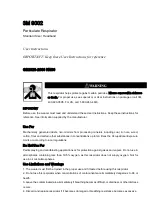
11
Acroline
Carbonyls
Hydrogen Selenide Ozone
Aniline
Cyanogen
Methanol
Phosgene
Arsine
Dimethylaniline
Phosphine
Boron Hydrides
Dimethyl Sulfate
Methylene
Chloride, Methyl
Bromide, Methyl
Chloride
Phosphorous Trichloride
Bromine
Ethyl Cyanide
Nitro Compounds:
Nitrogen Ox-
idesNitroglycerin-
NitrobenzeneNi-
tromethane
Stibine
Carbon Dioxide
Fluorine
Sulfur Chloride
Carbon Monoxide Hydrogen Cyanide
Vinyl Chloride
V. HOW TO INSTALL CHEMICAL CARTRIDGES AND PARTICULATE FILTERS
A. Mercury Vapor Cartridges
Special or Critical User’s Instructions: The mercury vapor cartridges incorporate
passive end-of-service-life indicators (ESLIs). Each ESLI, yellow in color when
new, turns to gray when exposed to mercury vapor. Do not use these cartridges
unless you can distinguish between the safe and discard colors of the ESLI. The
indicators must be visible when wearing the respirator without having to manipu-
late either the facepiece or the indicator. If the indicator cannot be seen, do not
wear the respirator. The cartridges must be replaced when the ESLIs change color
from yellow to gray, when the ESLIs become dirty or damaged, after 30 days of
use, or if removed from their original packaging and not used within 30 days. Never
enter or remain in a hazardous atmosphere if one or more of the ESLIs is gray.
B. Particulate Filters
Before using a particulate filter, you must confirm the atmosphere is non-IDLH
and not oxygen deficient, the contaminant is a particulate hazard, and you must
determine the hazard ratio (hazard concentration/exposure limit). If the hazard
ratio is less than 10, you may use a half mask respirator with a filter efficiency of
95% or higher. If the hazard ratio is less than 20, you may use a full facepiece
respirator with a filter efficiency of 95% or higher. If the hazard ratio is less than
100, you may use a full facepiece respirator with a filter efficiency of 99% or higher.
If the hazard ratio is greater than 100, you must use another type of respirator.
N-series filters must only be used for non-oil containing aerosols or particulates.
R or P-series filters can be used if the atmosphere contains oil (e.g., lubricants,
cutting fluids, glycerin, etc.). An R-series filter used in an oil containing atmosphere
must be replaced after each 8-hour work shift. A P-series filter can be used for
more than one 8-hour work shift. Please refer to section XI, Particulate Filter Ser-
vice Life, for important additional information.
Refer to
NIOSH Guide to the Selection and Use of Particulate Respirators Certified Un
-
der 42CFR84
for additional guidelines on use limitations for filters.
Содержание SURVIVAIR Opti-Fit S-Series
Страница 22: ...22 www sperianprotection com...








































